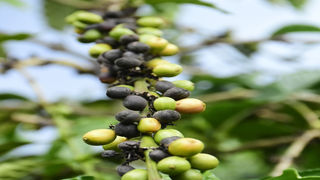
Coffee berries in a garden. The coffee value chain farmer can gain economic benefits from carbon trade. PHOTO/ Edgar R. batte
|Prosper
Prime
Opportunities in carbon trade
What you need to know:
- Carbon has gained an economic value that allows people, companies and nations to trade in it.
In Uganda, carbon markets are growing. But they must do so quickly, if Uganda is to meet the global targets of cutting back man-made greenhouse gas emissions over the coming decade.
To keep global warming to no more than 1.5°C – as called for in the Paris Agreement – emissions should be reduced by 45 percent by 2030 and reach net zero by 2050.
Mr Geoffrey Kimenya, project lead at Solidaridad country office, one of the organisations helping Ugandans to cash in on their efforts to seclude carbon emissions on their farmland says carbon farming is making sure that whatever you farm, carbon is not emitted but being contained in the soil. Carbon has gained an economic value that allows people, companies and nations to trade in it.
Carbon farming is a business model that aims at upscaling climate mitigation by paying farmers to implement climate-friendly farm management practices.
According to Mr Kimenya, carbon farming can be agroforestry, sustainable land management practices or regenerative agriculture. The idea is about farmers decarbonising their value chains.
He says it can be specifically for the coffee value chain, tea value chain, cocoa, cereals and many others. They have already started working on a big inspection on these value chains as they want to walk the talk.
For coffee, which is the flagship commodity for Uganda currently, they want to see how farmers can make sure that the coffee they produce is sustainable.
“We integrate agroforestry in coffee farming systems. We shall bring an approach of agroforestry development whereby, we work with farmers to access tree seedlings. We work with institutions such as National Coffee Research Institution and National Forestry Research Institution to provide site specific matching to know the specific trees that can be planted, in which cropping systems and what management aspects can be employed, “Mr Kimenya says.
He clarifies, “This is to make sure that the coffee productivity is not reduced and this should be sustainable. If we do that, we incentivise farmers to change their behaviour, to retain trees in their crop farming systems for a long period of time.
They also work with international partners such as Rabobank to connect them to the Acorn carbon market. In persuading farmers to switch to carbon farming, Mr Kimenya says there are voluntary carbon markets out there, that a lot of companies want to decarbonise or be carbon neutral, giving an example of Microsoft and Standard Chartered, who are already part of this.
He says they are getting the money to make sure their companies are carbon neutral.
Acorn platform and Rabobank are working with them to channel carbon credits to smallholder farming savings.
Price of carbon
According to Mr Kimenya, the simple calculation is one hectare of coffee farming with about 60 trees will generate about seven tonnes of carbondioxide in a year.
“We actually generate close to €115 per year, on one hectare of land, which is about Shs445,000.”
This money is little, however, corporates and institutions in markets are holding discussions over increasing the price of carbon from €20(Shs76.772.42). So far, Acorn is currently offering the best carbon prices.
“We want to see if it can move from €20(Shs76.772.42) to €40(Shs153,444.85) or €50(Shs191,806.07). This will be a turning phenomenon to provide payment to smallholder farming savings.
‘‘With carbon trading, you incorporate a tree into your farming system to absorb carbondioxide while giving you fruits. A mango tree give you an extra income because it also stores carbon credits,” Mr Kimenya.
Here, the farmers are able to farm climate smartly - good agricultural practices.
Although they have done a lot of training in good agricultural practices, farmers need to trigger their brains, to make sure this is more resilient and sustainable.
Challenges
Mr Kimenya says the challenge is that for one to get sequenced quantities of carbondioxide, you need some big piece of land that is from at least one acre to 10 hectares.
There are farmers that have less than an acre and are looking at this as a big challenge to calculating sequestering carbon credits.
However, they also want to see a method where they can cluster farmers who are on the same landscape, and their farms are all close together.
Mr Kimenya says these can be clustered if there is carbon credit sequestered and form a village association, where their credit can be paid to run their day to day activities. That is sustainability as well as helping smallholder farmers with minimum land to benefit.
Mr Robert Charles Aguma, the environment health and safety officer at the Ministry of Agriculture, says the world is suffering from global warming which is affecting weather patterns.
“…Weather is unpredictable. We have long droughts and short rainy seasons. So carbon farming is a very good initiative because it is trying to reverse those negative effects of climate change. When we store carbon in trees, we are ensuring that we are reducing the impact that would otherwise have affected agricultural productivity,” Mr Aguma says.
He says it also helps to contribute to income enhancement of the farmers, because the carbon is being sold to international markets under the voluntary carbon scheme. That is a very good initiative since nobody would shy away from earning money to keep their trees standing.
Mr Aguma says carbon is measured in terms of tonnes of carbon per hectare and the bigger the tree, the more carbon it absorbs. They have methods of measuring how much carbon is stored by a particular tree.
Normally, you measure the volume of the tree based on the diameter and height to know how much carbon this tree has absorbed these tonnes of carbon.
Mr Richard Kigenyi, the warden forest restoration, Kibale National Park, says if you cut a tree or burn it, you are releasing carbon into the atmosphere. Conversely, as the tree grows, it absorbs carbon and stores it.
“Uganda Wildlife Authority, which is in charge of Kibale National Park assesses how much carbon has been stored into these forests every three years. There are special machines that we use but we still look at the size of the tree stem and the size of the crown as different tree species have different growth characteristics,” Mr Kigenyi says.
After they have done that, validators come to see the methodology they have used, and if it is well, you qualify to take your carbon to market.
Between 2017 and 2020, Solidaridad collected 221 tonnes of carbon per hectare and in the whole project area in three years, they were able to collect 236,000 tonnes.
He added that when that carbon was put on the market about Shs1 billion was collected.




